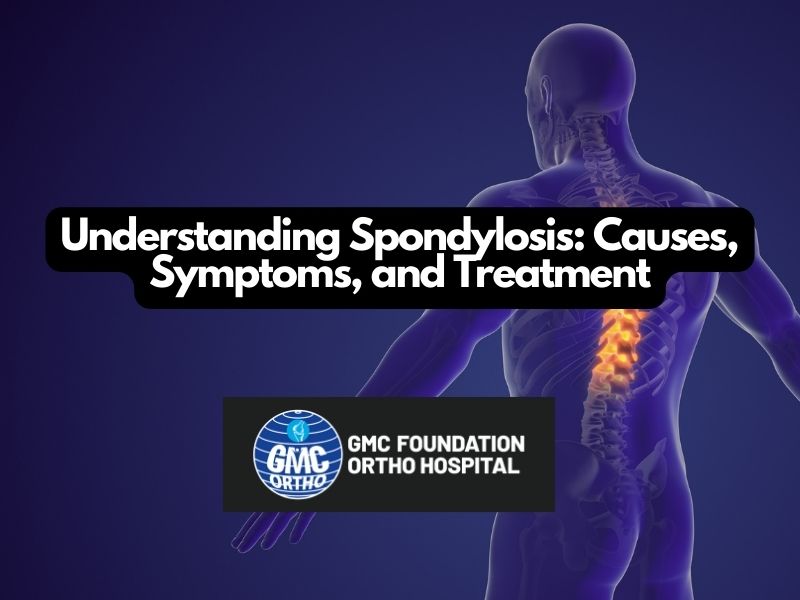9633789014

East Nadakkave, Kozhikode, 673011 9633789014
Book an Appointment
Note: This is an appointment request only Depending on the availability of the consultant, appointment will be confirmed to you through mail/call The appointment requests can be made minimum 48 hrs in advance

Understanding Spondylosis: Causes, Symptoms, and Treatment
June 10, 2024Spondylosis is a general term used to describe age-related changes in the spine, particularly the degeneration of the intervertebral discs and the formation of bone spurs. It is commonly associated with osteoarthritis of the spine. While it can affect any part of the spine, it is most frequently seen in the cervical (neck) and lumbar (lower back) regions.
What is Spondylosis?
Spondylosis refers to the wear and tear of the spinal discs and vertebrae. It encompasses a range of degenerative changes, including:- Disc Degeneration:
- The intervertebral discs, which act as cushions between the vertebrae, lose their water content and elasticity over time. This leads to a reduction in disc height and the potential for disc herniation.
- Bone Spurs (Osteophytes):
- As the discs degenerate, the body may form bone spurs in an attempt to stabilize the spine. These bony growths can press on nerves or the spinal cord, causing pain and other symptoms.
- Facet Joint Arthritis:
- The facet joints, which connect the vertebrae to each other, can become arthritic, leading to pain and stiffness.
Causes of Spondylosis
Several factors contribute to the development of spondylosis:- Aging:
- The natural aging process is the primary cause. As we age, the spinal discs and joints undergo degenerative changes.
- Genetics:
- A family history of spine problems can increase the likelihood of developing spondylosis.
- Repetitive Stress:
- Occupations or activities that involve repetitive spinal movements or heavy lifting can accelerate wear and tear.
- Injury:
- Previous spinal injuries can predispose an individual to spondylosis.
- Obesity:
- Excess body weight puts additional stress on the spine, contributing to disc degeneration and joint wear.
Symptoms of Spondylosis
The symptoms of spondylosis can vary depending on the severity and location of the degenerative changes. Common symptoms include:- Pain:
- Chronic pain in the affected area of the spine (neck, lower back, etc.).
- Pain may radiate to the shoulders, arms, buttocks, or legs if nerve compression is involved.
- Stiffness:
- Reduced flexibility and stiffness in the spine, especially after periods of inactivity or upon waking.
- Numbness and Tingling:
- Sensations of numbness, tingling, or a "pins and needles" feeling in the extremities due to nerve compression.
- Muscle Weakness:
- Weakness in the muscles served by the affected nerves.
- Limited Range of Motion:
- Difficulty moving the spine through its full range of motion.
- Headaches:
- In the case of cervical spondylosis, headaches can occur, often starting at the back of the head and moving towards the front.
Diagnosis
To diagnose spondylosis, healthcare providers may use a combination of methods:- Medical History and Physical Examination:
- Discussing symptoms and conducting a physical exam to assess pain, range of motion, and neurological function.
- Imaging Tests:
- X-rays: To visualize bone spurs and disc space narrowing.
- MRI (Magnetic Resonance Imaging): To assess soft tissue structures, including discs and nerves.
- CT Scan (Computed Tomography): To provide detailed images of the spine's bony structures.
Treatment Options
Treatment for spondylosis aims to relieve symptoms and improve quality of life. Options include:- Conservative Treatments:
- Medications: Pain relievers (acetaminophen), nonsteroidal anti-inflammatory drugs (NSAIDs), and muscle relaxants.
- Physical Therapy: Exercises to strengthen the back and neck muscles, improve flexibility, and reduce pain.
- Heat and Cold Therapy: Applying heat or cold packs to reduce pain and inflammation.
- Lifestyle Modifications: Weight management, ergonomic adjustments, and avoiding activities that exacerbate symptoms.
- Injections:
- Corticosteroid Injections: To reduce inflammation and pain in the affected area.
- Epidural Steroid Injections: For nerve-related pain.
- Surgical Treatments:
- Surgery is considered when conservative treatments fail to provide relief, and symptoms significantly affect quality of life. Surgical options may include:
- Discectomy: Removal of a herniated disc portion.
- Laminectomy: Removal of a portion of the vertebrae to relieve pressure on the spinal cord or nerves.
- Spinal Fusion: Joining two or more vertebrae to stabilize the spine.
- Surgery is considered when conservative treatments fail to provide relief, and symptoms significantly affect quality of life. Surgical options may include:
Prevention Tips
While aging is inevitable, certain measures can help slow the progression of spondylosis:- Regular Exercise:
- Engage in activities that promote spinal health, such as walking, swimming, and strength training.
- Maintain a Healthy Weight:
- Keeping a healthy weight reduces stress on the spine.
- Good Posture:
- Practice good posture to reduce strain on the spine during daily activities.
- Ergonomics:
- Use ergonomic furniture and make adjustments to your workspace to support spinal health.
- Avoid Smoking:
- Smoking can accelerate disc degeneration and reduce blood flow to the spine.
